Spring has sprung here in Michigan; time to get cracking on lots of projects. One of our new projects is an investigation of pre-plant techniques for dealing with root systems on container grown trees. As many of you know, Linda Chalker-Scott is advocate of bare-rooting trees before planting to correct potential root defects before planting. As some of you may know, I’m skeptical of this approach. It’s not that I think root systems are perfect – far from it. But we lack sufficient information to know whether the costs of bare-rooting (time/effort, stress on the trees) warrant the benefits. We also have little information on how species vary in responding to bare-rooting. From the experience of foresters and bare-root liner nurseries we know that some species are highly sensitive to storage and handling when they’re bare-rooted. When I worked for International Paper, we had little difficulty transplanting sycamores bare-root; whereas we often encountered severe dieback or mortality with sweetgum. Likewise, shade tree nurseries often encounter difficulty establishing oaks, baldcypress, and hackberry from bare-root liners. In fact, J. Frank Schmidt and Sons nursery, one of the largest producers of shade tree liners has discontinued production of bare-root hackberry lines and only produces them as container stock.
As I said, I’m skeptical that putting a tree through the trauma of bare-rooting is worth the potential benefit. But I’m also open-minded and willing to conduct an objective trial to see what’s what. As an aside, I was skeptical about root-shaving before we conducted our own trial and was impressed by the results. For our current study we planted 96 container-grown shade trees last week at the MSU Horticulture Teaching and Research Center. Trees includes three cultivars: ‘Bloodgood’ London planetrees, columnar tulip poplar and ‘October glory’ red maple. We assigned the trees at random to one of four treatments: Control (no root treatment), Shave (outer roots removed before planting) and two bare-root treatments – Bare root – Wash (trees were bare-rooted by washing the roots with water) and Bare root – Airspade (trees were bare-rooted using an airspade). The planting crew consisted of my technician, Dana Ellison; my new Master’s student, Riley Rouse; my undergrad assistants, Becky Pobst and Alex Love; and Linda, who was on-hand to provide quality control on the bare-rooting operations.
For her M.S. project, Riley will be tracking performance of the trees over the next two years. Her measurements will include tree survival and growth as well as measures of physiological responses such as plant water potential and photosynthetic gas exchange. Next fall, after two growing seasons, we will dig a subset of the trees with a tree spade and inspect the root systems to determine the effect of treatments on root system development. In the meantime, here are some photos from last week’s festivities.




































